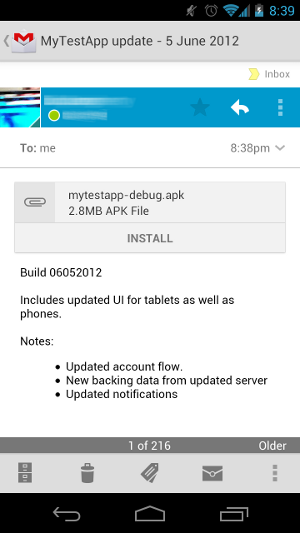As an open platform, Android offers choice. You can distribute your Android apps to users in any way you want, using any distribution approach or combination of approaches that meets your needs. From publishing in an app marketplace to serving your apps from a web site or emailing them directly users, you’re never locked into any particular distribution platform.
The process for building and packaging your apps for distribution is the same, regardless of how you distribute them. This saves you time and lets you automate parts of the process as needed. You can read Preparing for Release for more information.
The sections below highlight some of the alternatives for distributing your apps.
Distributing Through an App Marketplace
Usually, to reach the broadest possible audience, you’d distribute your apps through a marketplace, such as Google Play.
Google Play is the premier marketplace for Android apps and is particularly useful if you want to distribute your apps to a large global audience. However, you can distribute your apps through any app marketplace you want or use multiple marketplaces.
Unlike other forms of distribution, Google Play allows you to use the In-app Billing service and Licensing service. The In-app Billing service makes it easy to sell in-app products like game jewels or app feature upgrades. The Licensing service helps prevent unauthorized installation and use of your apps.
Distributing Your Apps by Email

Figure 1. Users can simply click Install when you send them an application via email.
An easy and quick way to release your apps is to send them to users by email. To do this, you prepare the app for release, attach it to an email, and send it to a user. When the user open your email on their Android-powered device, the Android system recognizes the APK and displays an Install Now button in the email message (see Figure 1). Users can install your app by touching the button.
Distributing apps through email is convenient if you’re sending them to a few trusted users, as it provides few protections from piracy and unauthorized distribution; that is, anyone you send your apps to can simply forward them to others.
Distributing Through a Website
If you don’t want to release your apps on a marketplace such as Google Play, you can make them available for download on your own website or server, including on a private or enterprise server. To do this, you first prepare your apps for release in the normal way. Then all you need to do is host the release-ready APK file on your website and provide a download link to users.
When users browse to the download link from their Android-powered devices, the file is downloaded and Android system automatically starts installing it on the device. However, the installation process will start automatically only if users have configured their Settings to allow the installation of apps from unknown sources.
User Opt-In for Apps from Unknown Sources

Figure 2. Users must enable the Unknown sources setting before they can install apps not downloaded from Google Play.
Android protects users from inadvertent download and install of apps from locations other than Google Play (which is trusted). It blocks such installs until the user opts-in Unknown sources in Settings > Security, shown in Figure 2. Users need to make this configuration change before they download your apps to their devices.
Note that some network providers don’t allow users to install applications from unknown sources.